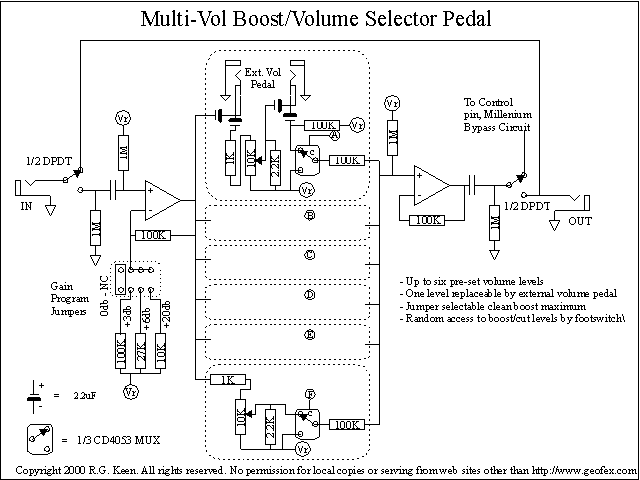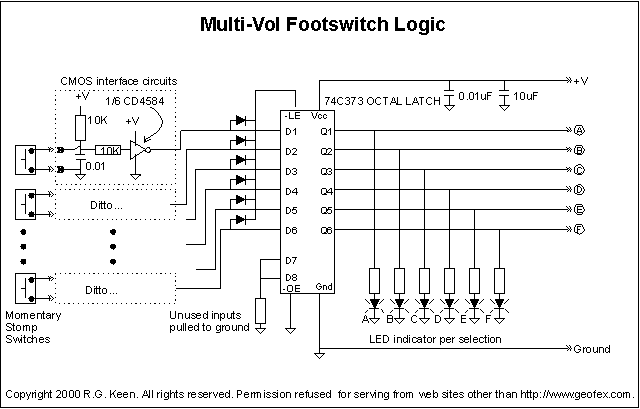Multi-Vol Pedal - Selectable Fixed and Variable Volume
Settings
Copyright 2000 R.G. Keen. All rights reserved.
No permission for local copies or serving from web sites other than http://www.geofex.com.
This article is based on a request from Claude - I think it solves his
problem!
When you're on stage, a volume pedal is a really useful accessory. However,
there are times when you want to get to a specific volume level quickly and with
some precision to get a specific sound. This can be done with a fully variable
rocker style pedal, but it can be really nice to have some pre-sets available
too. The Multi-vol can do exactly that.
 The semi-schematic for the
Multi-vol appears at the right. There is a provision for a true bypass around
the whole mess for when you just want it all to be gone. If the signal is routed
into the effect, it first hits a buffer opamp, which reproduces the signal for
driving the variable stages. The buffer opamp has a jumper selectable gain,
depending on where the jumper is set on the gain selection block. If you don't
need this feature, you can simply leave the whole gain selection block off.
The semi-schematic for the
Multi-vol appears at the right. There is a provision for a true bypass around
the whole mess for when you just want it all to be gone. If the signal is routed
into the effect, it first hits a buffer opamp, which reproduces the signal for
driving the variable stages. The buffer opamp has a jumper selectable gain,
depending on where the jumper is set on the gain selection block. If you don't
need this feature, you can simply leave the whole gain selection block off.
From the buffer, the signal drives up to six volume presets. These presets
are shown in the dotted rectangles in the center of the picture. Each pre-set
contains the volume setting pot and a switch that either allows the signal from
the level setting pot through or grounds the output of the block. The signals
that determine whether the signal is allowed through or not are shown as circled
letters "A" through "F". These will come from the switching
controller. Suffice it to say that only one of these signals will be high at at
time, so only one of the preset levels will be selected.
Preset "A" is special in that it contains a pair of "normalling"
jacks that allow you to plug in an external rocker-style volume pedal so that
one of the instant access presets is a variable rocker pedal. This way you get
five presets and a variable, toe-touch selectable.
The outputs of all the preset stages are combined into the non-inverting
input of a second opamp, which buffers the selected preset to the output.
The preset pots are all linear 10K pots, converted to "audio" taper
by the 2.2K resistor. These can be PCB-mount pots with an integral knob for
compactness.
The actual signal switching is done by two CD4053 analog multiplex chips.
These chips each contain three SPDT switches which can be controlled by
individual logic signals. The key to getting pop-free switching with these chips
is to keep the inputs and outputs for analog signals near the center of their
power supply. This is provided by the DC coupling used throughout except in
preset A. Here, coupling capcitors block the DC to the switch, so one connection
to Vref must be provided by a bias resistor.
 Selection of one and only
one of the presets is done by a couple of other CMOS logic chips. A set of six
momentary switches to ground drive a individual debouncing networks and Schmitt
trigger CMOS inverter gates to make a clean logic transitions on the inputs of a
74C373 octal D-latch IC.
Selection of one and only
one of the presets is done by a couple of other CMOS logic chips. A set of six
momentary switches to ground drive a individual debouncing networks and Schmitt
trigger CMOS inverter gates to make a clean logic transitions on the inputs of a
74C373 octal D-latch IC.
This chip contains eight flipflops. The individual D inputs are driven by the
pulses from the Schmitt triggers, and diodes "OR" all the data inputs
together to drive the Latch Enable pin. So when any one of the Data signals goes
high, Latch Enable is driven high, and the single D input which is high is
latched into its matching flipflop. The other D inputs are all low, so they are
latched with low level signals.
The six Q outputs that are used drive a resistor/LED indicator per output to
show which preset is active, and also the switch signal to the corresponding
preset switch section on the CD4053's; this gates the right analog signal
through.
Access to any of the six presets is instantaneous; just tap the corresponding
footswitch and that preset is enabled. The "A" preset is either the
pot or an external rocker pedal (or anything else for that matter... hey! could
we make a one-of-six selector out of this??? Yep...)
 The semi-schematic for the
Multi-vol appears at the right. There is a provision for a true bypass around
the whole mess for when you just want it all to be gone. If the signal is routed
into the effect, it first hits a buffer opamp, which reproduces the signal for
driving the variable stages. The buffer opamp has a jumper selectable gain,
depending on where the jumper is set on the gain selection block. If you don't
need this feature, you can simply leave the whole gain selection block off.
The semi-schematic for the
Multi-vol appears at the right. There is a provision for a true bypass around
the whole mess for when you just want it all to be gone. If the signal is routed
into the effect, it first hits a buffer opamp, which reproduces the signal for
driving the variable stages. The buffer opamp has a jumper selectable gain,
depending on where the jumper is set on the gain selection block. If you don't
need this feature, you can simply leave the whole gain selection block off. Selection of one and only
one of the presets is done by a couple of other CMOS logic chips. A set of six
momentary switches to ground drive a individual debouncing networks and Schmitt
trigger CMOS inverter gates to make a clean logic transitions on the inputs of a
74C373 octal D-latch IC.
Selection of one and only
one of the presets is done by a couple of other CMOS logic chips. A set of six
momentary switches to ground drive a individual debouncing networks and Schmitt
trigger CMOS inverter gates to make a clean logic transitions on the inputs of a
74C373 octal D-latch IC.